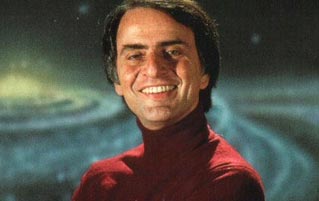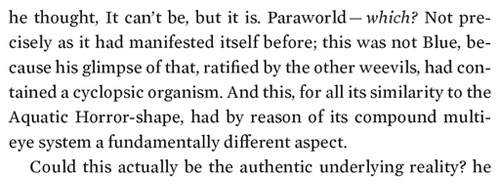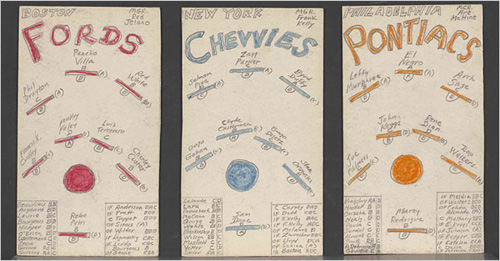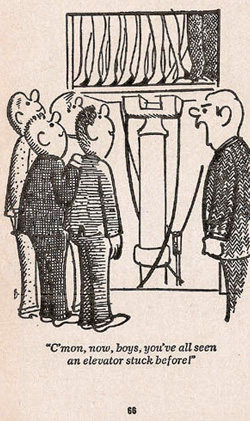6 Literary Turds (Written By Your Favorite Authors)

A lot of people tend to assume that great authors and artists are flawless geniuses. That the likes of Ernest Hemingway can drunkenly vomit up a bowl of alphabet soup, and whatever it spelled out would still make it on the Pulitzer shortlist. Unlike us mere mortals, true artists should be incapable of screwing up.
But even the best writers are capable of churning out work that wouldn't even cut the mustard on a Twilight meets Minions erotic fiction blog. Prepare to lose a little respect for a few big names. Names like ...
Philip K. Dick Plops An Acid Trip In The Middle Of A Novel

It's hard to overstate the influence Philip K. Dick has had on modern science fiction. If you've ever seen a sci-fi flick -- Blade Runner, Minority Report, you name it -- chances are that it was based on one of his stories. Unfortunately, that unique vision was the result of, as we've mentioned before, Dick being pretty nuts -- and while this often feeds creative genius, it also had the power to inspire the literary equivalent of a bad acid trip. By that, we mean that Dick literally wrote about an acid trip in his less-than-seminal book Lies, Inc.

Sadly, not actually a novel about the Silver Surfer starting a law firm.
The book begins as an interesting story about the invention of teleportation and a distant Utopian planet that may not be all it's cracked up to be. But then, in the middle of this exciting narrative, the protagonist gets shot by an LSD-tipped dart for no apparent reason. This results in no fewer than a hundred winding pages detailing the specifics of this psychedelic trip, only for the original story to abruptly start up again. Imagine if Atticus Finch accidentally ate some shrooms and spent the rest of To Kill A Mockingbird riding a flying salamander through a forest of giant eyelashes. Good, now you're in the right head space to read the following:

While we could chalk this up to the brilliance of a true original thinker, the actual reason behind it is the same reason most college freshman essays end up in double-spaced 18-point font. The original pulp story, The Unteleported Man, was about half the length of a novel, and, as was the practice at the time, Dick was asked to double the story's length for a paperback release. Unfortunately, between turning in the original story and publisher Ace Books' plea for seconds, Dick had decided that he was done writing pulp like The Unteleported Man. He had also just started experimenting with LSD, and turning to the old creed of "write what you know," he decided to shift focus from space opera to space ball-tripping.

We can assume the artist made that choice long before him.
The draft was originally rejected by his publishers in a noble attempt to keep Dick from embarrassing himself. Then, in the '80s (the decade when everyone lost their sense of decency), Berkley Books acquired the rights to the original story and decided to squeeze the last bit of blood out of the then-dying sci-fi legend by releasing "The World Famous Classic Now Uncensored For The First Time," incoherent gaps and all, pretending that Ace Books had been stifling genius instead of protecting the reputation of a man who clearly couldn't handle his Class A drugs yet.
Carl Sagan's Essay On Smoking Pot Ruins Pot, Carl Sagan
Astronomer and turtleneck enthusiast Dr. Carl Sagan is best known as the author of several sciencey books that we totally understand, but won't go into now because we don't, uh, want to make someone else feel stupid. Yeah, that makes sense. Sagan's the man whose musings on the universe enchanted entire generations to gaze at the sky and wonder. He's like everybody's awesome nerdy dad. And like all dads, that of course means he was bound to embarrass us. In his case, by painstakingly describing how rad it is to smoke some reefer.

Weed also explains the choice of a velour turtleneck and sports coat.
In 1971, Sagan penned an essay about how awesome smoking pot is -- likely the first one not written on the back of a pizza box and comprised mainly of Steely Dan lyrics. Not wanting to be outed as a closet pothead, Sagan wrote the essay (published in the book Marihuana Reconsidered) under the unsubtle pseudonym Mr. X, presumably because "Dr. Otto Von Fakename" was already taken by Stephen Hawking for his essay extolling the virtues of crystal meth.
Embarrassingly, the essay goes on to break down the minutiae of a painfully standard high, such as describing how the shadow of a house plant looked like a small Volkswagen "down to hubcaps, license plate, chrome, and even the small handle used for opening the trunk," and how the flame of a candle began to look like a liquor company mascot. Not exactly "Lucy In The Sky With Diamonds," doc.

Surprisingly, "Dr. Lester Grinspoon" is not a pseudonym.
Of course, Sagan didn't just rip on bongs to improve his scientific skills. He also used it to, like, expand his mind, man. In the essay, he admits that he "never much appreciated" art before rocking the ganj. And as much as you might not want to picture Dr. Carl Sagan doing the nasty, he also goes into detail about how much better sex is while you're stoned. In one particularly baffling anecdote, a super-high Sagan hops in the shower with his wife, and then manages to solve racism using the magic of math.

Must've been a long shower.
Famed Occultist Aleister Crowley Wrote Sappy Love Poetry
Aleister Crowley, the so-called "Wickedest Man in the World," was a master of the occult and founder of his own religion who shocked early 20th-Century England with his deviant weirdness. He's probably best known for writing a buttload of books on such great evils as ancient gods, black magic, and yoga. But before all that, Crowley dabbled in the distinctly un-evil arena of lovesick poetry, jotting down his feelings in a notebook.

Of course he wrote them sideways. Being annoyingly difficult was his true first love.
Like any proper goth, the "Great Beast" was once a romantic young student. After a love affair with a female impersonator ended in a bad breakup, Crowley, with no Smiths records or tubs of Ben and Jerry's at his disposal, turned to the written word to ease his pain. This is where his life turned decidedly My Chemical Romance. Titles include Love me or leave me, Your love is light, and I, who am dying for thy kiss. There's even a tome comparing his love to an octopus:

Crowley ended up destroying most of his early poetry -- not because it firmly outed him as a practicing bisexual in a time when being anything other than a sexless heterosexual could get you imprisoned (he couldn't give a tuppence worth of fucks about that), but because it made him look like a sobbing weak-willed teenager rather than a master of the dark arts. It's hard enough to convince people to join a weird cult without a leader who writes erotic prose that makes you hungry for seafood.

Not even carving that onto a tombstone is gonna save your rep, bruh.
Speaking of people obsessed with monstrous mollusks ...
H.P. Lovecraft's Essay About How Awesome Cats Are Gets Real Racist Real Fast
When he wasn't shitposting editors, H.P. Lovecraft was truly one of the greats of horror literature, penning such classics as The Call Of Cthulhu and At The Mountains Of Madness. But for some reason, the guy famous for writing about winged tentacle monsters also saw it fit to jot down his thoughts about how super cool he thought kitty cats were.

And before the internet, that opinion was usually restricted to Broadway theater.
As befitting his style, Lovecraft's love for the feline persuasion came from a deeply fearful, antisocial place. Which is why he spends most of the article talking smack about how useless dogs are, praising cats' "superior imaginative inner life" as opposed to a dog's "pitiful" dependence on companionship. It's the kind of thing you'd expect to find in the diary of a seven-year-old with anger issues, not the collected works of a horror icon.

At least the cat still looks like it wants to eat your soul.
But the hate didn't just stop at dogs. Even though the essay starts out as a socially inept love letter to cats, Lovecraft quickly found a way to make it super racist. Going on a bit of an unexpected tangent, he nonchalantly makes it clear that he considers black people to be as different from "human beings" as farm animals or even "pterodactyls" -- in perhaps the one and only example of Jurassic racism.

Hate finds a way.
Leave it to the master of creeping unease to sour what is basically an extended version of that Facebook post about cats and dogs your aunt keeps reposting. After the bout of casual racism, the piece devolves into a one-percenter pro-fascist rant, using cats and dogs as an allegory for the aristocracy and the poor:


He also enjoyed comparing cats to "superior men" -- which, in 1937, must have really been a shot in the arm for all those Nazis with "Hang In There" posters on their walls. Eventually, Lovecraft's editors decided to step in and remove all of the overt racism and fascism for future publications of the essay. "Wrong kind of crazy," they must've muttered to themselves as they longingly recalled when Lovecraft was just about weird tentacle gods causing madness and mass suicides.
Jack Kerouac Spent Way Too Much Time On An Insanely Elaborate Fantasy Baseball League
One of the founders of the Beat movement, Jack Kerouac is best remembered as that gonzo writer guy your pothead college roommate wouldn't shut up about. From his work, one might assume that a guy like Kerouac was only into jazz, drugs, and general filthy beatnik-ism. But you'd be wrong. Kerouac had an intense hobby, one he kept secret from his fellow cool artist friends like Ginsberg and Burroughs: fantasy baseball.
When we say fantasy baseball, we don't mean the modern version in which fans pick the perfect combination of players. No, Kerouac made up an entire league, in which all the teams, players, and games were the product of his imagination.

An imagination so ahead of the game that he named the teams after the sponsors.
Starting as a teenage obsession, Kerouac's created his very own baseball board game -- which he made with a marble and a toothpick. To flesh out the concept, he developed a fantasy league which featured teams like the Pittsburgh Plymouths and the Cincinnati Blacks, and players with names such as Wino Love, Zagg Parker, and Phegus Cody. Not only did he record the fictitious games, full of detailed statistics, but he even wrote about the games for pretend newsletters under the alias "Jack Lewis," a magazine publisher and "turf luminary" who had married a wealthy horse breeder. That's some seriously dedicated world-building. Even George R.R. Martin doesn't care enough about the minute details to type up The Westeros Daily Tribune.


On The Road was originally going to be a collection of box scores from teams' away games.
Kerouac kept writing these newsletters throughout most of his life, typing up his last two mock United Press International reports 11 years before his death. In that time, he also ran an imaginary horse racing circuit in which the winners were determined, just like in the baseball leagues, by rolling marbles. So if any English students out there are ever intimidated by On The Road, simply imagine its author firing marbles around his room while imagining they're athletes with improbably silly names.

No word on if he'd break his thumbs after losing bets to his make-believe bookie.
The Berenstains You Loved As A Child Wrote A Series Of Dirty Joke Books

One of the cornerstones of any American childhood has to be the Berenstain Bears books, the beloved stories about an adorable bear family ... which aggressively judges whichever one of them displays the tiniest of flaws.

It all comes to a head in Berenstain Bears: When Brother Takes A Swing At Papa.
Stan and Jan Berenstain never hid their contempt for children misbehaving all that well. Before they went in for the most obvious pun on their names, they created the comic book Be Good Or I'll Belt Ya!, which promises to explain "What really happens between parents and children" -- mainly yelling, destruction of property and a whole lot of casual violence against minors.

Lovecraft would not approve of the cat abuse, either.
But despite all of the holier-than-thou moralizing of these children's books, the Berenstains actually cut their teeth in the world of dirty joke books. For instance, there's the Lover Boy series, comics filled "jokes" about the hilarious misadventures of men and their extramarital affairs, spousal abuse, and workplace harassment.

Now you know why there was never a Berenstain Bears And The Objectification Of Women book. Had Brother Bear been caught with one of these scandalous paperbacks, there probably would have been a whole book dedicated to him explaining bruises to teachers.


These are the jokes switching to paperless offices robbed you of.
They even tried their hands at humorous sex education books, such as What Dr. Freud Didn't Tell You. Apparently, what Sigmund Freud omitted from his writings were a whole bunch of weird naked doodles about hot moms and lecherous creeps grabbing a woman's ankle.

The top-right drawing would eventually become that classic children's book The Berenstain Bears And The Penis Envy.
Zoroastrianism used to be one of the biggest religions in the world, but their idea of heaven had a slight twist on it: To get there you'd have to cross a bridge, sometimes rickety, sometimes wide and sturdy. If you fell off, you'd go to the House of Lies for eternity. Fun! Not terrifying at all! This month, Jack, Dan, and Michael, along with comedians Casey Jane Ellison and Ramin Nazer discuss their favorite afterlife scenarios from movies, sci-fi, and lesser-known religions. Get your tickets here, and we'll see you on the other side of the bridge!
Also check out 6 Famous Artists You Didn't Know Were Perverts and 7 Famous Artists You Didn't Know Were Perverts (Pt. 2).
Subscribe to our YouTube channel, and check out Quentin Tarantino's Gay Revenge Fantasy, and other videos you won't see on the site!
Also, follow us on Facebook, and let's be best friends forever.




